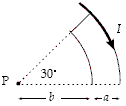If a = 2.0 cm, b = 5.0 cm, and I = 20 A, what is the magnitude of the magnetic field at the point P?

a.
4.5 ?T
b.
7.5 ?T
c.
9.0 ?T
d.
6.0 ?T
e.
3.6 ?T
d
You might also like to view...
Assume you charge a comb by running it through your hair and then hold the comb next to a bar magnet. Do the electric and magnetic fields produced constitute an electromagnetic wave?
1.Yes they do, necessarily. 2.Yes they do, because charged particles are moving inside the bar magnet. 3.They can, but only if the electric field of the comb and the magnetic field of the magnet are perpendicular. 4.They can, but only if both the comb and the magnet are moving. 5.They can, if either the comb or the magnet or both are accelerating.
Size of the Nucleus: An excited  U* nucleus undergoes fission into two fragments as follows:
U* nucleus undergoes fission into two fragments as follows: U* ?
U* ?  Ba +
Ba +  KrIf, at the instant of fission, the Ba and Kr fragments are spherical and just barely in contact, what is the electrostatic potential energy of these two fragments? (1 eV = 1.60 × 10-19 J, e = 1.60 × 10-19 C, 1/4??0 = 8.99 ×
KrIf, at the instant of fission, the Ba and Kr fragments are spherical and just barely in contact, what is the electrostatic potential energy of these two fragments? (1 eV = 1.60 × 10-19 J, e = 1.60 × 10-19 C, 1/4??0 = 8.99 ×
109 N ? m2/C2) A. 230 MeV B. 240 MeV C. 250 MeV D. 260 MeV E. 270 MeV
According to the way the layers of Earth's atmosphere are defined in the following figures, the atmosphere of Venus has only _________ distinct layer(s).
a. one b. two c. three d. four e. five
Auroras are caused by
a. gases fluorescing in the atmosphere because of collisions with solar wind particles. b. the magnetosphere of Earth touching its atmosphere. c. the ozone layer being destroyed by UV light. d. a product of the atmospheric greenhouse effect. e. scattering of sunlight from particles in Earth's stratosphere.